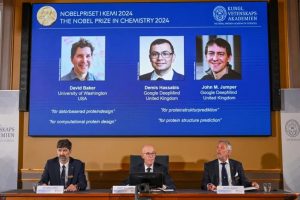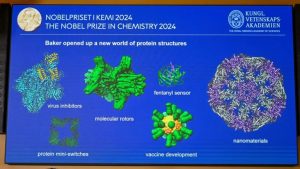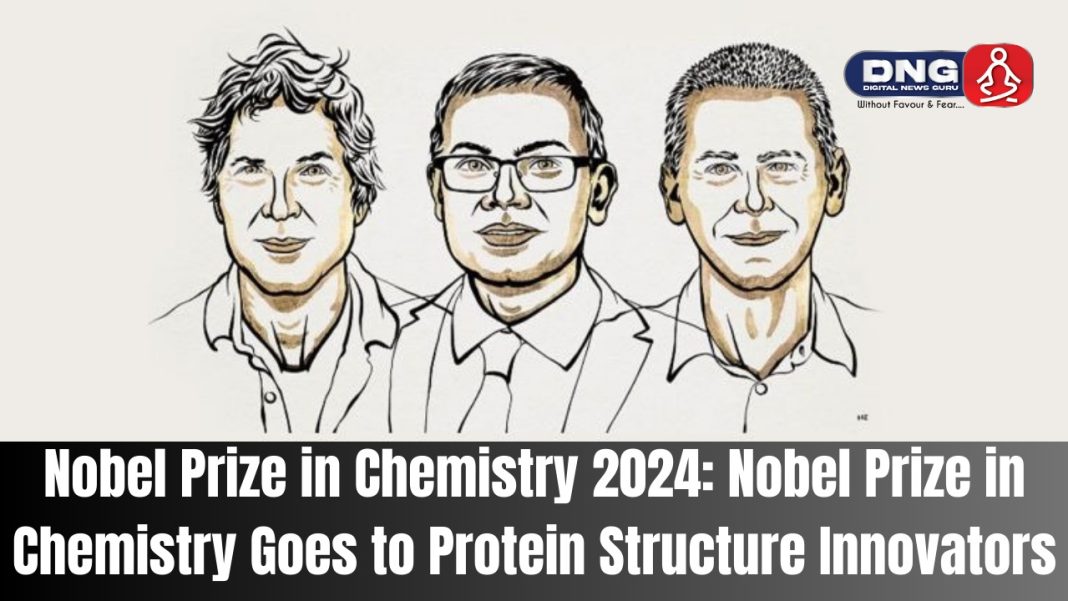DIGITAL NEWS GURU DELHI DESK:
Nobel Prize in Chemistry 2024: Nobel Prize in Chemistry Goes to Protein Structure Innovators
On October 9, 2024, the Nobel Prize in Chemistry was awarded to three scientists—David Baker, Demis Hassabis, and John M. Jumper—for their groundbreaking work on protein structures.

Baker was recognized for his innovations in computational protein design, while Hassabis and Jumper were honored for their contributions to protein structure prediction using artificial intelligence. This research is pivotal as proteins are essential to numerous biological processes, making understanding their structures crucial for advancements in medicine and biotechnology.
Overview of the Research

Proteins, composed of chains of amino acids, perform a vast array of functions in living organisms, from catalyzing biochemical reactions to forming structural components of cells. The complexity of protein structure arises from the various combinations and arrangements of 20 different amino acids, leading to an impressive diversity in form and function. The Nobel committee emphasized that the work of these three scientists has significantly advanced the field of protein science, providing new insights into how proteins fold and function, which is crucial for drug development and understanding diseases.
Significance of the Award

The 2024 Nobel Prize carries a monetary reward of 11 million Swedish kronor (approximately $1 million), with half awarded to Baker for his work on computational protein design. The other half will be shared between Hassabis and Jumper for their collaborative efforts on protein structure prediction.
This acknowledgment not only highlights the importance of their individual contributions but also underscores the growing intersection of artificial intelligence and biological research.
Hassabis and Jumper are associated with Google DeepMind, the AI research lab known for its pioneering work in developing AlphaFold2, a groundbreaking AI model that predicts protein structures with remarkable accuracy. Their work has been described as a monumental step in resolving a long-standing challenge in biology, significantly enhancing our understanding of how proteins interact and behave.
Impact on Science and Medicine
The implications of this research extend far beyond the realm of chemistry. The ability to accurately predict protein structures is a game-changer for drug discovery and development. For instance, it can accelerate the design of new pharmaceuticals by allowing researchers to understand how drugs interact with their protein targets at a molecular level. This can lead to more effective treatments for various diseases, including cancer and genetic disorders, by enabling the design of tailored therapeutic strategies.
Moreover, the methodologies developed by Baker, Hassabis, and Jumper are likely to inspire further innovations in the field of synthetic biology, where the ability to design new proteins could lead to the creation of novel enzymes, vaccines, and even biofuels. Their work exemplifies how interdisciplinary approaches can yield transformative advancements, illustrating the profound potential of combining computational techniques with traditional biological research.
Conclusion
The awarding of the Nobel Prize in Chemistry to David Baker, Demis Hassabis, and John M. Jumper marks a significant milestone in our understanding of proteins and their structures. Their research not only enhances the scientific community’s ability to explore the fundamental aspects of life but also paves the way for practical applications that could revolutionize medicine and biotechnology. As we continue to uncover the mysteries of proteins, the potential for new discoveries remains vast and exciting.
YOU MAY ALSO READ: Ratan Tata Passes Away at 86: India Mourns the Loss of Visionary Leader Ratan Tata








